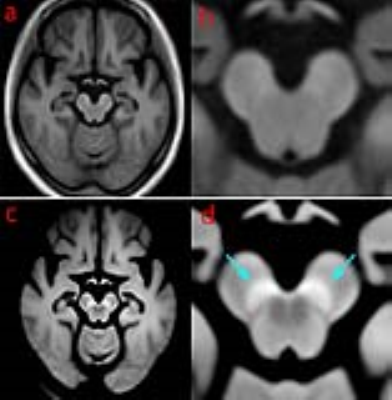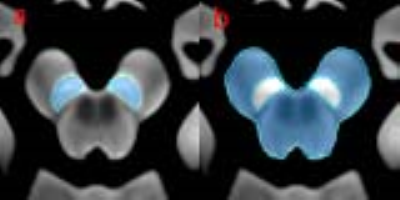3626
Visualization of Substantia Nigra Pars Compacta: MPRAGE vs. DANTE T1-SPACE1Department of Diagnostic Radiology and Nuclear Medicine, Graduate School of Medicine, Kyoto University, Kyoto, Japan, 2Human Brain Research Center, Graduate School of Medicine, Kyoto University, Kyoto, Japan, 3Siemens Healthineers, Portland, OR, United States, 4Siemens Healthineers, San Francisco, CA, United States
Synopsis
Neuromelanin-sensitive magnetic resonance techniques have been developed for depicting neuromelanin-rich structures such as substantia nigra pars compacta (SNpc). We compared visualization of SNpc between magnetization-prepared rapid gradient-echo imaging (MPRAGE) and delay alternating with nutation for tailored excitation-prepared T1-weighted variable flip angle turbo spin echo (DANTE T1-SPACE) in 21 healthy volunteers. DANTE T1-SPACE provided much better delineation of SNpc and showed higher signal intensity than MPRAGE. DANTE T1-SPACE can be used for evaluating SNpc.
Introduction
Substantia nigra pars compacta (SNpc) is a neuromelanin-rich brainstem structure. Neuromelanin can have paramagnetic T1-shortening effects when combined with metals, and neuromelanin-sensitive T1-weighted magnetic resonance (MR) imaging methods have been developed to identify SNpc1-5. These imaging techniques are thought to be useful for evaluating Parkinson’s disease3-5. Delay alternating with nutation for tailored excitation-prepared T1-weighted variable flip angle turbo spin echo (DANTE T1-SPACE) has been recently used for black-blood imaging, but SNpc is also visualized in high resolution DANTE T1-SPACE. The purpose of this study is to compare the visualization of SNpc between DANTE T1-SPACE and magnetization-prepared rapid gradient-echo imaging (MPRAGE), one of the standard 3D T1-weighted imaging methods.Methods
Subjects
This study was approved by the institutional review board. We enrolled 21 healthy elderly volunteers (11 males and 10 females; mean age 70, range 60-85 years) who underwent MRI including MPRAGE and DANTE T1-SPACE. Both scans were performed on the same day for each subject.
Image Acquisition
MR imaging was performed at a 3T MR scanner (MAGNETOM Skyra, Siemens Healthcare GmbH, Erlangen, Germany) with a 32-channel head coil.
MPRAGE
Imaging parameters were as follows: sagittal acquisition; repetition time (TR)/echo time (TE)/inversion time (TI), 1900 ms/2.58 ms/900 ms; flip angle, 9°; field of view (FOV), 230×230 mm; resolution, 0.9×0.9×0.9 mm; generalized autocalibrating partial parallel acquisition (GRAPPA), acceleration factor, 2; and acquisition time, 4 min 26 sec.
DANTE T1-SPACE
Parameters of the SPACE readout module were as follows: sagittal acquisition; TR/TE, 1000 ms/11 ms; variable flip angle ; echo train length, 60; FOV, 180×180 mm; resolution, 0.56×0.56×0.56 mm; Controlled Aliasing In Parallel Imaging Results IN Higher Acceleration (CAIPIRINHA), acceleration factor, 4; fat suppression; and acquisition time, 5 min 44 sec. Parameters of the DANTE preparation module were as follows: flip angle, 10°; RF duration, 0.08 ms; number of pulses, 148; total pulse duration, 167.24 ms; and spoiler gradient area, 18 mT/m*ms.
Post-imaging Procedure
All the images were analyzed using SPM12 software (Wellcome Department of Imaging Neuroscience, University College London, United Kingdom) implemented in MATLAB 2014b (Mathworks, Natick, MA). A DARTEL template was generated from the image data set of DANTE T1-SPACE. All subjects’ DANTE T1-SPACE images were warped into MNI space with a smoothing Gaussian filter (full width at half maximum, 0.56×0.56×0.56 mm), and thus normalized DANTE T1-SPACE images (swDANTE) were created. Then, mean swDANTE images were created (Figure 1). MPRAGE images were registered to the corresponding DANTE T1-SPACE images (rMPRAGE). After a DARTEL template was created from these images, all subjects’ images were transformed into MNI space to create swrMPRAGE images, and mean swrMPRAGE images were created (Figure 1).
Data Analysis
ROIs of SNpc and the neighboring midbrain (MB) were manually placed on 3 axial slices (upper, middle, and lower) using ImageJ software (National Institutes of Health, Bethesda, MD) (Figure 2). SNpc was easily recognized on DANTE T1-SPACE, while it was difficult to delineate on MPRAGE. Therefore, mean swDANTE images were used for ROI placement. This set of ROIs was applied to the individual MPRAGE and DANTE T1-SPACE images. The mean signal intensities (SI) of SNpc and MB were measured and contrast ratio was defined as follows: mean SI of SNpc divided by mean SI of MB on the same slice. Statistical analysis was performed to determine the difference in the contrast ratios of MPRAGE and DANTE T1-SPACE using paired t-test. P value less than 0.05 was considered to be statistically significant.
Results
Mean swrMPRAGE and swDANTE images are shown in Figure 1. MPRAGE and DANTE T1-SPACE images of a subject are shown in Figure 3. DANTE T1-SPACE was able to delineate SNpc much better than MPRAGE (Figure 1, 3). The average of contrast ratios was significantly higher in DANTE T1-SPACE than MPRAGE (P<0.001), suggesting better visualization of SNpc on DANTE T1-SPACE (Figure 4).Discussion
Neuromelanin-sensitive MR sequences have been developed to identify SNpc1-5. Loss of neuromelanin in SNpc is observed in Parkinson’s disease and is correlated with disease severity3-5. Therefore, neuromelanin imaging is thought to be a potential diagnostic and progression marker. In our study, DANTE T1-SPACE showed much better visualization of SNpc than MPRAGE, probably due to the magnetization transfer effect of DANTE T1-SPACE6. Acquisition time of DANTE T1-SPACE in this study (5 min 44 sec) is much shorter than that of conventional neuromelanin imaging3. DANTE T1-SPACE can be used as a viable imaging method for neuromelanin-rich structures as well as black-blood imaging, and may provide a potential tool for diagnosis and progression marker of Parkinson’s disease.Conclusion
DANTE T1-SPACE can be a better neuromelanin imaging tool to delineate SNpc than conventional MPRAGE.Acknowledgements
We are grateful to Mr. Katsutoshi Murata, Mr. Yuta Urushibata, and Mr. Hirokazu Kawaguchi, Siemens Healthcare Japan K. K., for their kind help.References
1. Sasaki M, Shibata E, Ohtsuka K, et al. Visual discrimination among patients with depression and schizophrenia and healthy individuals using semiquantitative color-coded fast spin-echo T1-weighted magnetic resonance imaging. Neuroradiology, 2010. 52(2): p. 83-9.
2. Enochs WS, Petherick P, Bogdanova A, et al. Paramagnetic metal scavenging by melanin: MR imaging. Radiology, 1997. 204(2): p. 417-23.
3. Sasaki M, Shibata E, Tohyama K, et al. Neuromelanin magnetic resonance imaging of locus ceruleus and substantia nigra in Parkinson's disease. Neuroreport, 2006. 17(11): p. 1215-8.
4. Schwarz ST, Xing Y, Tomar P, et al. In Vivo Assessment of Brainstem Depigmentation in Parkinson Disease: Potential as a Severity Marker for Multicenter Studies. Radiology, 2017. 283(3): p. 789-798.
5. Nakamura K, Sugaya K. Neuromelanin-sensitive magnetic resonance imaging: a promising technique for depicting tissue characteristics containing neuromelanin. Neural Regen Res, 2014. 9(7): p. 759-60.
6. Jones RA, Haraldseth O, Schjøtt J, et al. Effect of Gd-DTPA-BMA on magnetization transfer: application to rapid imaging of cardiac ischemia. J Magn Reson Imaging, 1993. 3(1): p. 31-9.
Figures



